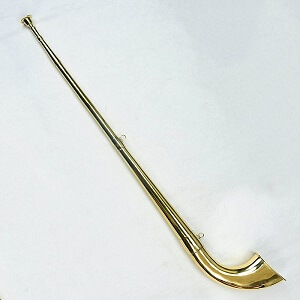Roman Tuba
 The tuba of ancient Rome is a military signal trumpet, quite different from the modern tuba. The tuba was produced around 500 BC. Its shape was straight, in contrast to the military buccina or cornu, which was more like the modern sousaphone in curving around the body. Its origin is thought to be Etruscan, and it is similar to the Greek salpinx. About four feet in length, it was made usually of bronze, and was played with a detachable mouthpiece. The Roman tuba was one of the most important music instruments in the Roman military. It could be used for parades and funerals, but the most important of its uses was to give orders to soldiers. People who played this instrument were called tubicines. In representations of people playing this instrument, they are usually pointing it up or down, rather than holding it level. They also just use one hand to hold it, as the other hand is placed on the hip to help dilate the torso.
The tuba of ancient Rome is a military signal trumpet, quite different from the modern tuba. The tuba was produced around 500 BC. Its shape was straight, in contrast to the military buccina or cornu, which was more like the modern sousaphone in curving around the body. Its origin is thought to be Etruscan, and it is similar to the Greek salpinx. About four feet in length, it was made usually of bronze, and was played with a detachable mouthpiece. The Roman tuba was one of the most important music instruments in the Roman military. It could be used for parades and funerals, but the most important of its uses was to give orders to soldiers. People who played this instrument were called tubicines. In representations of people playing this instrument, they are usually pointing it up or down, rather than holding it level. They also just use one hand to hold it, as the other hand is placed on the hip to help dilate the torso.
he Roman tuba was a long, straight horn usually made of bronze and averaging about four feet long and had a detachable bone mouthpiece. It was brought into military prominence around 500 B.C. as a giver of signals, such as the charge and retreat and changing of the guard. Its use was continued for many centuries afterwards. Mentioned by the earliest Latin authors such as Ennius, the tuba does not become prominent in art until the first century B.C.